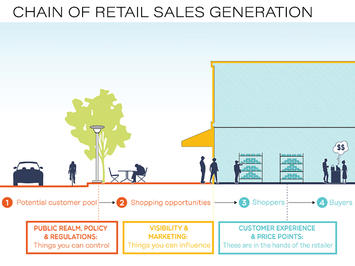
Considerations for downtowns, commercial corridors, and main streets
We are at the end of the beginning. There are going to be closures, vacancies, and job losses across communities. How long and how deep will be a function of how well the next three-to-six months are managed, how that impacts consumer confidence, and whether planners and development officials are ready to respond in meaningful ways. Moreover, the pandemic magnified and amplified glaring, pre-existing disparities in our civic and economic structure. How communities address vacancy, maintain a sense of vibrancy and ensure equitable action is at the heart of today’s challenges.
As designers and economists who have worked in urban revitalization for the past 20 years, we propose a framework for downtowns and main streets to consider - RESTART, RESET, RETOOL, REFILL
We are presently in the Restart phase, primarily driven by public health considerations. There are a number of open questions, among them will the customers come back, and will there be enough of them to support my business? Sources such as Open Table and consumer surveys reveal a cautiousness continuum within the population - 25% of customers are not likely to come back before there is a substantive improvement in clinical treatment or a vaccine is developed. 20%are likely to come back right away. We need to make the remaining 55% of customers more comfortable to take a calculated risk. To do so, the key transmission variables of time, space, people, and place need to be addressed. Changes made in the public realm should focus on experiential issues that build customer confidence that businesses are safe.
For event-driven businesses or cultural institutions, many commonly discussed concepts – like outdoor seating for restaurants – are not really options. These assets are the things that make downtowns and main streets different from other parts of your city. For these enterprises and anything that sold slots, seats, beds, or other forms of time, these revenues are gone forever while costs continue to accrue. We need to support these assets as they find new models to operate with severe and likely ongoing attendance restrictions.
As the shutdown began, financial time (revenues) and economic time (bills) remained aligned for many businesses due to federal, state, and local stabilization actions. However, this summer and early fall, unless additional legislative action is taken, revenue and fixed costs will become out of alignment. With less revenue coming in for the foreseeable future and fixed costs remaining constant, the viability of a number of otherwise healthy businesses may come into question. This means support may be needed to reset the financial clock again in ways that recognize the realities of individual businesses but are cognizant of the systemic impact through the financial system. For example, resetting leases for individual businesses also have implications for the value of the building (and property taxes), as well as any loan covenants that may exist on the property.
With limited resources it is critical that local leaders focus on the pieces you can control and influence and have a clear understanding of your specific circumstances. This will give you the best chance to refill the vacancies and rebuild the vibrancy of main streets. This requires that you (1) Take stock of the situation on the ground, (2) Define the problem you are solving, (3) Determine who to help and how, and (3) Create an inventory of the tools you have and how they can be used. This last one is critical, because not all places have the building blocks or right tools to recover and, even those that do, often lack the structure or deliberate thought process to promote equitable opportunity across the community.
There will be a temptation to focus on finding best practices or precedents to solve the myriad of economic issues that will arise in a COVID management world. What should be focused on is creating the right practices that best fit the circumstances of your community and situation. But you can’t do that unless you take an honest assessment of where you are starting from rather than where you would like to be. Cities will
recover. How long it takes will be a function of the public and private sectors’ ability to collaborate and focus on what is at stake block by block, business by business and customer by customer.
Download the full report here (PDF opens in new tab or window)
About the authors:
Kevin Hively is founder and president of Ninigret Partners, a business strategy and economic consulting firm. Over the last 20 years he has been working on economic development and city building projects across the country.
Scott Page founded Interface Studio to test and develop a unique and innovative set of urban design ideas. He has been a leader in developing innovative, national award winning neighborhood plans targeted toward enhancing communication, awareness and empowerment at the community level.
Sarah Kellerman is an urban planner, designer, and proven project manager with experience working across many scales and disciplines. She runs the Chicago Studio for Interface Studio.
Stacey Chen has led projects for Interface Studio ranging from comprehensive plans to neighborhood action plans addressing downtowns, industrial reuse and place making, climate resiliency and waterfront communities. Stacey brings an international perspective, cultural competence and an interest in social justice to her work.












